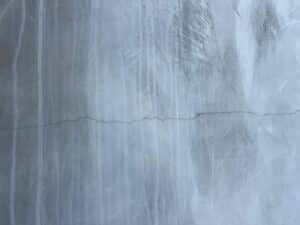To repoint a brick wall, you must remove the old mortar, blend and apply fresh mortar, and allow the new mortar to set. This procedure is vital in preserving the structural stability and aesthetic of brickwork. The technique of brick repointing guarantees the wall stays robust and climate-resistant.
In this article, we’ll discuss repointing brick walls more.
What Are the Steps to Repoint a Brick Wall?
The steps to repoint a brick wall are to remove the old mortar, prepare a new mixture, apply it, and then finish and clean it.
Step 1: Remove Old Mortar
The initial step in repointing a brick wall involves the meticulous removal of the old, deteriorated mortar. This process must be carried out with care to avoid damaging the bricks.
Specialised tools, such as a hammer and chisel or a joint raker, are typically used to scrape out the old mortar to a sufficient depth, ensuring a clean and solid base for the new mortar. The depth to which the mortar is removed is crucial; typically, it should be twice the width of the mortar joint.
Such a task is often undertaken by skilled remedial builders, who understand the nuances of such delicate work.
Step 2: Prepare New Mortar
Preparing new mortar is a critical step, requiring precision to ensure the mix is suitable for the specific requirements of the brickwork. The mortar mix must match the existing mortar in terms of strength, colour, and texture to maintain the wall’s integrity and aesthetic.
Generally, a standard mix includes one part cement to three parts sand, with lime added to improve workability and durability. The ingredients are thoroughly mixed with water until a consistent, workable paste is formed.

Step 3: Apply New Mortar
Applying the new mortar is a skilled task that demands attention to detail. This stage involves carefully pressing the mortar into the cleaned-out joints using a pointing trowel.
The mortar should be packed tightly to eliminate any air pockets, which can weaken the structure. The thickness of the mortar layer needs to be consistent with the original joints to maintain the wall’s uniformity.
Step 4: Finish and Clean
The finishing stage is crucial for achieving a neat and professional appearance. Once the mortar starts to set, which usually takes a few hours, the joints are shaped and finished using a jointing tool to match the existing pattern.
Excess mortar is carefully removed from the brick faces with a brush or damp cloth. The wall is left to cure, which can take several days, depending on the weather conditions.
What Tools Do I Need to Repoint Brick?
To repoint brick, you need tools and equipment such as a hammer and chisel, joint raker, pointing trowel, mortar mix, bucket, and safety gear, including gloves and goggles. These tools are essential for effectively and safely removing old mortar, preparing and applying new mortar, and ensuring a neat finish.
The hammer and chisel are indispensable for chipping away the old mortar without damaging the bricks. Precision in this step is crucial for maintaining the wall’s structural integrity. A joint raker might also be used to remove mortar from deeper joints.
A pointing trowel is vital for applying the new mortar. Its design allows for precise control and helps in compacting the mortar into the joints evenly, ensuring a strong bond and preventing future deterioration.
The mortar mix, typically a blend of cement, sand, and sometimes lime, needs to be prepared in a bucket. Getting the right consistency is essential for ease of application and for the mortar’s longevity once set.
Lastly, safety gear such as gloves and goggles is non-negotiable. Repointing can generate dust and debris, and gloves and goggles protect against potential injuries.
Can I Repoint Brickwork By Myself?
Yes, you can repoint brick by yourself, especially if you have the right tools and experience. Basic knowledge of masonry is necessary to repoint brick together with patience and precision.
